brake fluid HONDA CIVIC COUPE 1998 Owners Manual
[x] Cancel search | Manufacturer: HONDA, Model Year: 1998, Model line: CIVIC COUPE, Model: HONDA CIVIC COUPE 1998Pages: 251, PDF Size: 2.04 MB
Page 140 of 251
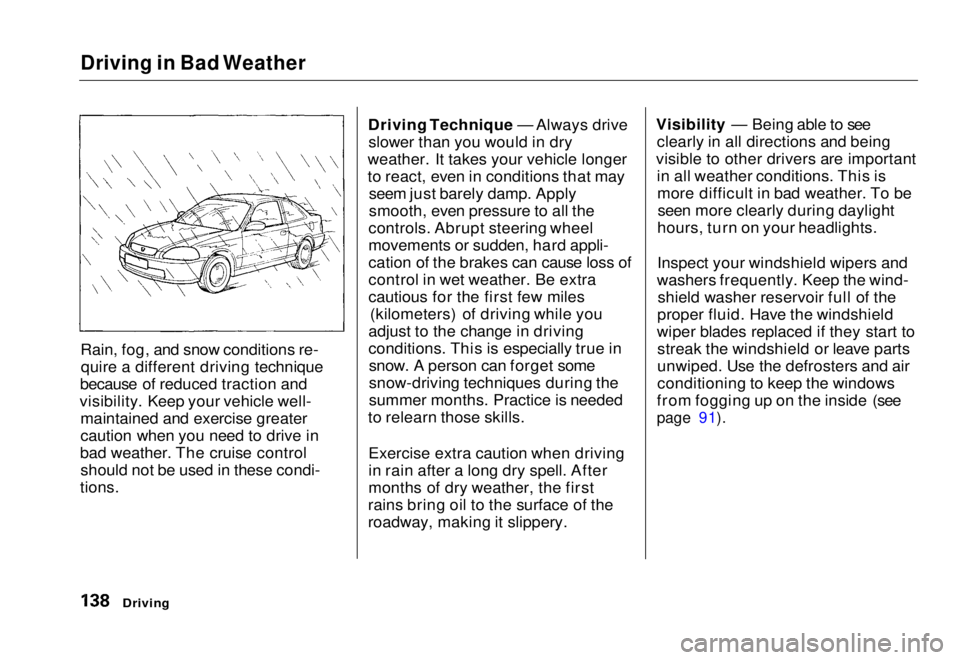
Driving in Bad Weather
Rain, fog, and snow conditions re-
quire a different driving technique
because of reduced traction and
visibility. Keep your vehicle well- maintained and exercise greater
caution when you need to drive in
bad weather. The cruise control should not be used in these condi-
tions. Driving Technique — Always drive
slower than you would in dry
weather. It takes your vehicle longer
to react, even in conditions that may seem just barely damp. Apply
smooth, even pressure to all the
controls. Abrupt steering wheel
movements or sudden, hard appli-
cation of the brakes can cause loss of
control in wet weather. Be extra
cautious for the first few miles (kilometers) of driving while you
adjust to the change in driving
conditions. This is especially true in snow. A person can forget some
snow-driving techniques during the
summer months. Practice is needed
to relearn those skills.
Exercise extra caution when driving
in rain after a long dry spell. After
months of dry weather, the first
rains bring oil to the surface of the
roadway, making it slippery. Visibility — Being able to see
clearly in all directions and being
visible to other drivers are important in all weather conditions. This ismore difficult in bad weather. To beseen more clearly during daylight
hours, turn on your headlights.
Inspect your windshield wipers and
washers frequently. Keep the wind- shield washer reservoir full of the
proper fluid. Have the windshield
wiper blades replaced if they start to streak the windshield or leave parts
unwiped. Use the defrosters and air
conditioning to keep the windows
from fogging up on the inside (see
page 91).
DrivingMain Menu Table of Contents s t
Page 142 of 251
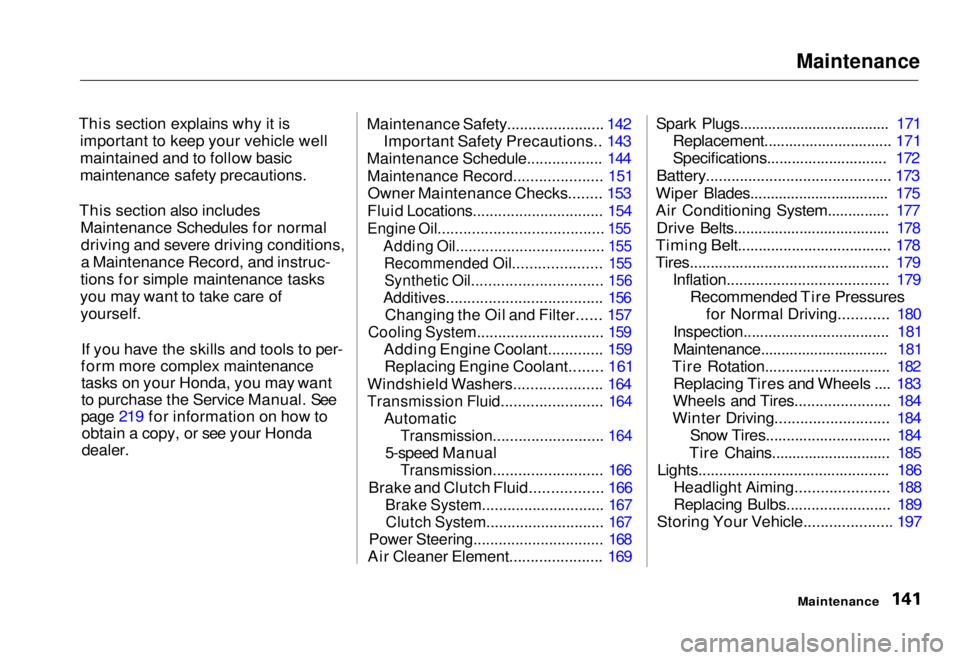
Maintenance
This section explains why it is important to keep your vehicle well
maintained and to follow basic
maintenance safety precautions.
This section also includes Maintenance Schedules for normaldriving and severe driving conditions,
a Maintenance Record, and instruc-
tions for simple maintenance tasks
you may want to take care of yourself.
If you have the skills and tools to per-
form more complex maintenance tasks on your Honda, you may want
to purchase the Service Manual. See
page 219 for information on how to obtain a copy, or see your Honda
dealer.
Maintenance Safety....................... 142
Important Safety Precautions.. 143
Maintenance Schedule.................. 144
Maintenance Record..................... 151
Owner Maintenance Checks........ 153
Fluid Locations............................... 154
Engine Oil....................................... 155 Adding Oil................................... 155Recommended Oil..................... 155Synthetic Oil............................... 156
Additives..................................... 156
Changing the Oil and Filter...... 157
Cooling System.............................. 159
Adding Engine Coolant............. 159Replacing Engine Coolant........ 161
Windshield Washers..................... 164
Transmission Fluid........................ 164
Automatic
Transmission.......................... 164
5-speed Manual
Transmission.......................... 166
Brake and Clutch Fluid................. 166
Brake System............................. 167Clutch System............................ 167
Power Steering............................... 168
Air Cleaner Element...................... 169 Spark Plugs..................................... 171
Replacement............................... 171
Specifications............................. 172
Battery............................................ 173
Wiper Blades.................................. 175
Air Conditioning System............... 177 Drive Belts...................................... 178
Timing Belt..................................... 178
Tires................................................ 179 Inflation....................................... 179
Recommended Tire Pressures
for Normal Driving............ 180
Inspection................................... 181
Maintenance............................... 181
Tire Rotation.............................. 182
Replacing Tires and Wheels ....
183
Wheels an d
Tires....................... 184
Winter Driving........................... 184 Snow Tires.............................. 184
Tire Chains............................. 185
Lights.............................................. 186 Headlight Aiming...................... 188
Replacing Bulbs......................... 189
Storing Your Vehicle..................... 197
MaintenanceMain Menu s t
Page 154 of 251
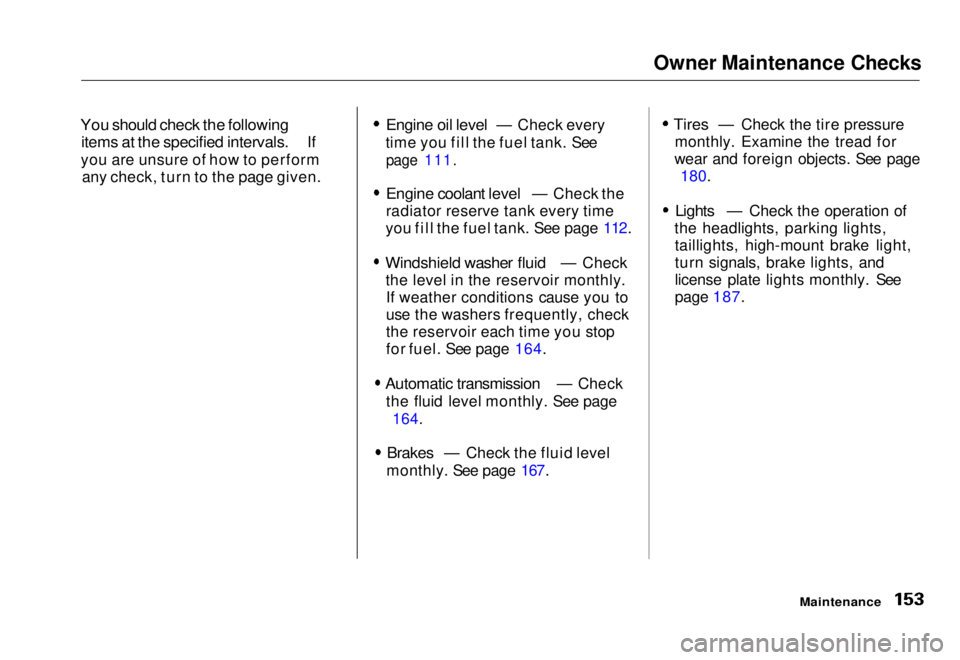
Owner Maintenance Checks
You should check the following
items at the specified intervals.
If
you are
unsure of how to perform
any check, turn to the
page given.
Engine oil level
— Check every
time you
fill the fuel tank. See
page 111.
Engine coolant level
— Check the
radiator reserve
tank every time
you fill the fuel tank. See page 112.
Windshield washer fluid
— Check
the level
in the reservoir monthly.
If weather conditions cause you to
use the washers frequently, check
the reservoir each time you stop
for fuel. See page 164.
Automatic transmission
— Check
the flui d
level monthly. See page
164.
Brakes — Check the fluid level
monthly. Se e
page 167.
Tires
— Check the tire pressure
monthly. Examin e
the tread for
wear and foreign objects. See page 180.
Lights — Check the operation of
the headlights ,
parking lights,
taillights, high-mount brake light,
turn signals, brake lights, and
license plate lights monthly. See
page 187.
MaintenanceMain Menu Table of Contents s t
Page 155 of 251
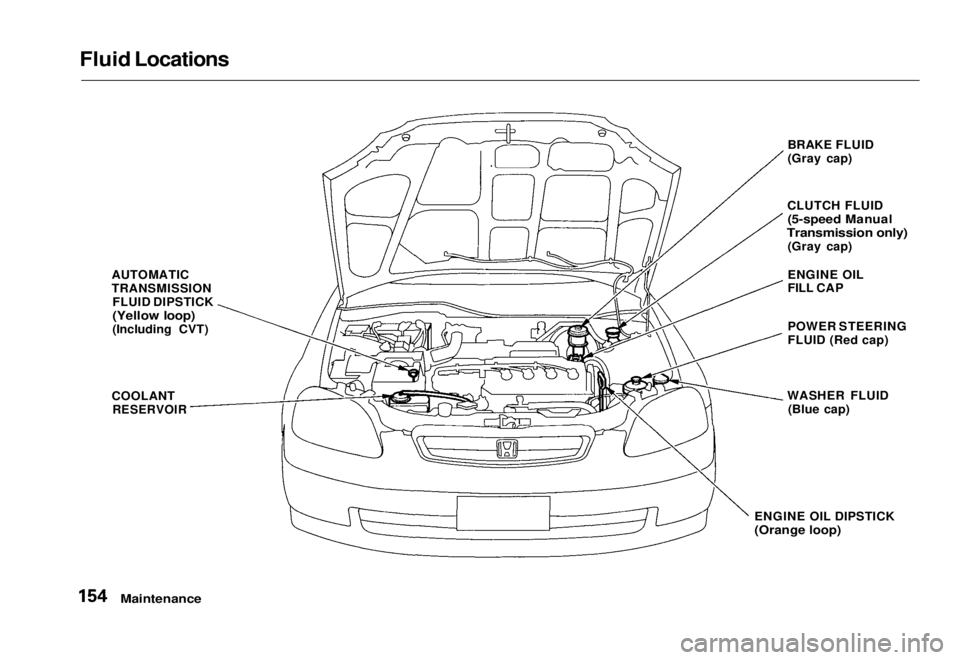
Fluid Locations
AUTOMATIC
TRANSMISSIONFLUID DIPSTICK
(Yellow loop)
(Including CVT)
COOLANT
RESERVOIR
BRAKE FLUID
(Gray cap)
CLUTCH FLUID
(5-speed Manual
Transmission only)
(Gray cap)
ENGINE OIL
FILL CAP
POWER STEERING
FLUID (Red cap)
WASHER FLUID (Blue cap)
ENGINE OIL DIPSTICK
(Orange loop)
MaintenanceMain Menu Table of Contents s t
Page 167 of 251
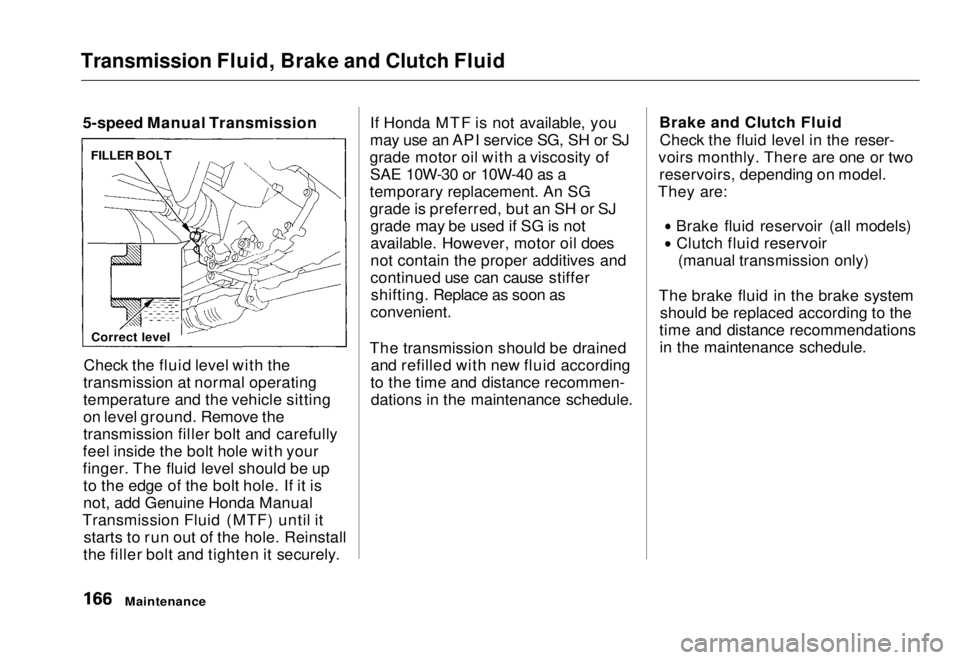
Transmission Fluid, Brake and Clutch Fluid
5-speed Manual Transmission
Check the fluid level with the
transmission at normal operating
temperature and the vehicle sitting
on level ground. Remove the
transmission filler bolt and carefully
feel inside the bolt hole with your
finger. The fluid level should be up to the edge of the bolt hole. If it is
not, add Genuine Honda Manual
Transmission Fluid (MTF) until it starts to run out of the hole. Reinstall
the filler bolt and tighten it securely. If Honda MTF is not available, you
may use an API service SG, SH or SJ
grade motor oil with a viscosity of SAE 10W-30 or 10W-40 as a
temporary replacement. An SG
grade is preferred, but an SH or SJ grade may be used if SG is not
available. However, motor oil does
not contain the proper additives and
continued use can cause stiffershifting. Replace as soon as
convenient.
The transmission should be drained and refilled with new fluid according
to the time and distance recommen- dations in the maintenance schedule. Brake and Clutch Fluid
Check the fluid level in the reser-
voirs monthly. There are one or two reservoirs, depending on model.
They are:
Brake fluid reservoir (all models)Clutch fluid reservoir (manual transmission only)
The brake fluid in the brake system should be replaced according to the
time and distance recommendations in the maintenance schedule.
Maintenance
FILLER BOLT
Correct levelMain Menu Table of Contents s t
Page 168 of 251
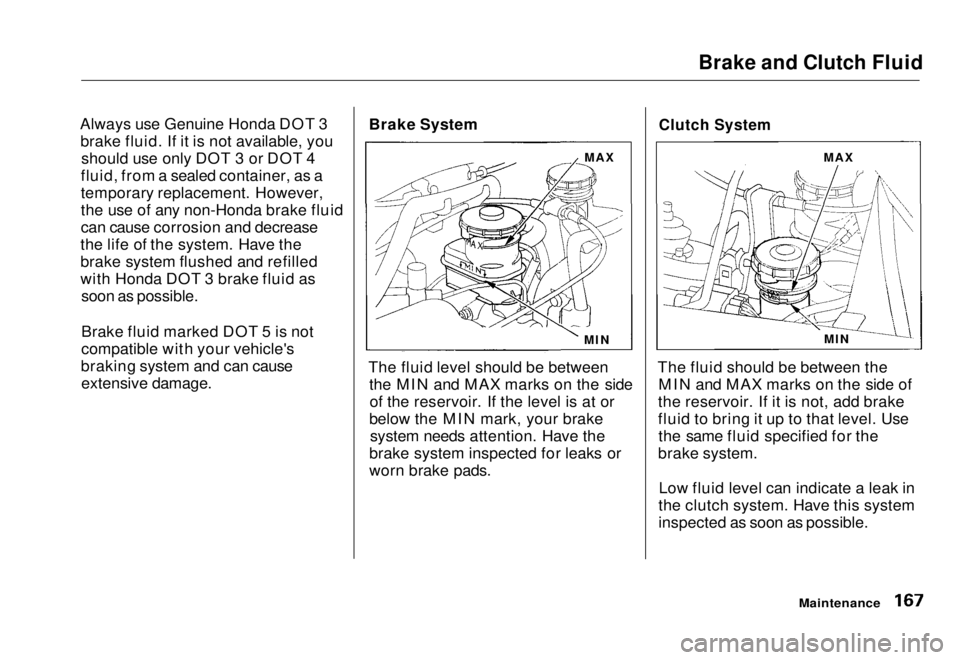
Brake and Clutch Fluid
Always use Genuine Honda DOT 3 brake fluid. If it is not available, you should use only DOT 3 or DOT 4
fluid, from a sealed container, as a
temporary replacement. However,
the use of any non-Honda brake fluid
can cause corrosion and decrease
the life of the system. Have the
brake system flushed and refilled
with Honda DOT 3 brake fluid as soon as possible.
Brake fluid marked DOT 5 is not
compatible with your vehicle's
braking system and can cause extensive damage. Brake System
The fluid level should be between the MIN and MAX marks on the sideof the reservoir. If the level is at or
below the MIN mark, your brake system needs attention. Have the
brake system inspected for leaks or
worn brake pads.
Clutch System
The fluid should be between the MIN and MAX marks on the side of
the reservoir. If it is not, add brake
fluid to bring it up to that level. Use the same fluid specified for the
brake system.
Low fluid level can indicate a leak in
the clutch system. Have this system
inspected as soon as possible.
Maintenance
MAX
MIN MAX
MINMain Menu Table of Contents s t
Page 220 of 251
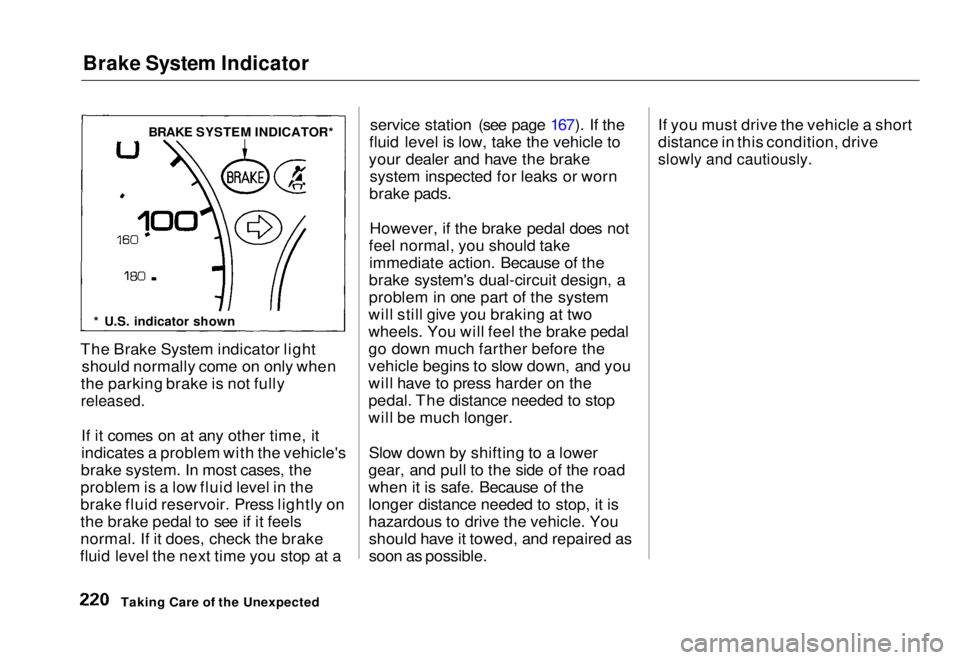
Brake System Indicator
The Brake System indicator light should normally come on only when
the parking brake is not fully
released.
If it comes on at any other time, it
indicates a problem with the vehicle's
brake system. In most cases, the
problem is a low fluid level in the
brake fluid reservoir. Press lightly on
the brake pedal to see if it feels
normal. If it does, check the brake
fluid level the next time you stop at a service station (see page 167). If the
fluid level is low, take the vehicle to
your dealer and have the brake system inspected for leaks or worn
brake pads.
However, if the brake pedal does not
feel normal, you should take immediate action. Because of the
brake system's dual-circuit design, a
problem in one part of the system
will still give you braking at two
wheels. You will feel the brake pedal
go down much farther before the
vehicle begins to slow down, and you will have to press harder on the
pedal. The distance needed to stop
will be much longer.
Slow down by shifting to a lower
gear, and pull to the side of the road
when it is safe. Because of the
longer distance needed to stop, it is
hazardous to drive the vehicle. You should have it towed, and repaired as
soon as possible. If you must drive the vehicle a short
distance in this condition, drive
slowly and cautiously.
Taking Care of the Unexpected BRAKE SYSTEM INDICATOR*
* U.S. indicator shownMain Menu Table of Contents s t
Page 246 of 251

Gasoline:
Unleaded gasoline, pump octane
number of 86 or higher.
Fuel Tank Capacity:
11.9 US gal (45 l, 9.9 Imp gal)
Recommended Engine Oil:
API Service SJ "Energy
Conserving" oil, SAE 5W-30
viscosity (see page 155).
DX:
3.8 US qt (3.6 l, 3.2 lmp qt)
U.S.: HX, EX, Canada: Si
3.5 US qt (3.3 l, 2.9 lmp qt)
Automatic Transmission Fluid:
Honda Premium
Formula Auto-
matic Transmission Fluid (ATF)
HX model (CVT)
only:
Use Honda CVT Fluid only 5-speed Manual Transmission
Fluid:
Honda Manual Transmission
Fluid preferred, or an API service
SG, SH or SJ,
10W-30 or 10W-40
motor oil as a temporary
replacement (see page 166).
Capacity (including differential):
1.9 US qt (1.8 l, 1.6 lmp qt)
Power Steering Fluid:
Genuine Honda Power Steering
Fluid preferred, or another brand
of power steering fluid as a
temporary replacement. Do not
use ATF (see page 168).
Brake
Fluid:
Genuine Honda DOT 3 Brake Fluid
preferred, or a DOT 3 or DOT 4
brake fluid as a temporary
replacement (see page
166).
Tire Pressure (measured cold):
Front:
30 psi (210 kPa , 2.1 kgf/cm2)
Rear:
29 psi (200 kPa , 2.0
kgf/cm2
)
Spare Tire Pressure:
60 psi (420 kPa , 4.2
kgf/cm 2
)
Service
Information SummaryMain Menu s t
Page 247 of 251
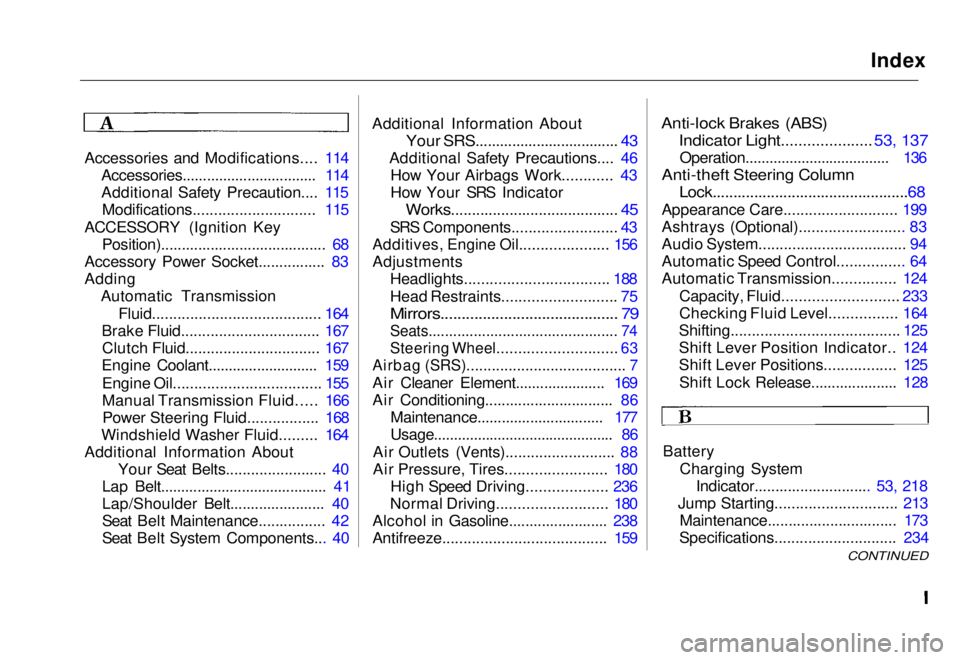
Index
Accessories and Modifications.... 114 Accessories................................. 114
Additional Safety Precaution.... 115Modifications............................. 115
ACCESSORY (Ignition Key Position)........................................ 68
Accessory Power Socket................ 83
Adding Automatic Transmission
Fluid........................................ 164
Brake Fluid................................. 167 Clutch Fluid................................ 167
Engine Coolant........................... 159
Engine Oil................................... 155
Manual Transmission Fluid..... 166Power Steering Fluid................. 168
Windshield Washer Fluid......... 164
Additional Information About Your Seat Belts........................ 40
Lap Belt......................................... 41
Lap/Shoulder Belt....................... 40
Seat Belt Maintenance................ 42
Seat Belt System Components... 40 Additional Information About
Your SRS................................... 43
Additional Safety Precautions.... 46 How Your Airbags Work............ 43
How Your SRS Indicator
Works........................................ 45
SRS Components......................... 43
Additives, Engine Oil..................... 156
Adjustments
Headlights.................................. 188
Head Restraints........................... 75
Mirrors.......................................... 79
Seats.............................................. 74
Steering Wheel............................ 63
Airbag (SRS)...................................... 7
Air Cleaner Element...................... 169
Air Conditioning............................... 86 Maintenance............................... 177
Usage............................................. 86
Air Outlets (Vents).......................... 88
Air Pressure, Tires........................ 180 High Speed Driving................... 236
Normal Driving.......................... 180
Alcohol in Gasoline........................ 238
Antifreeze....................................... 159
Anti-lock Brakes (ABS)
Indicator Light.....................
53, 137
Operation.................................... 13 6
Anti-thef
t Steering Column
Lock...............................................68
Appearance Care........................... 199
Ashtrays (Optional)......................... 83
Audio System................................... 94
Automatic Speed Control................ 64
Automatic Transmission............... 124
Capacity, Fluid........................... 233
Checking Fluid Level................ 164
Shifting........................................ 125
Shift Lever Position Indicator.. 124
Shift Lever Positions................. 125
Shift Lock Release..................... 128
Battery Charging SystemIndicator............................ 53,
218
Jump Starting............................ .
213
Maintenance............................... 173
Specifications............................. 234
CONTINUEDMain Menu s t
Page 248 of 251
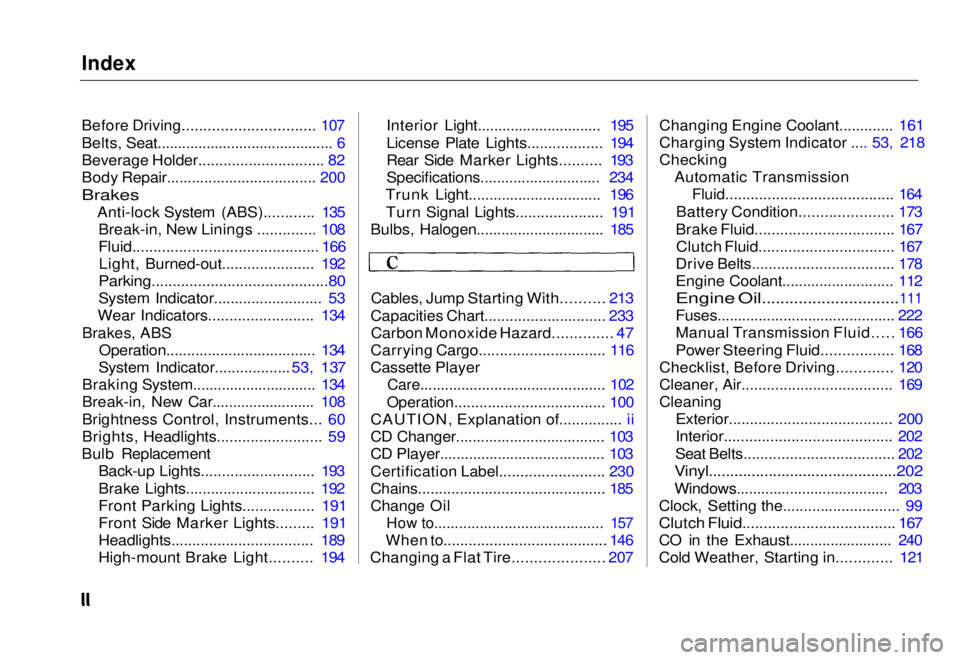
Index
Before Driving............................... 107
Belts, Seat........................................... 6
Beverage Holder.............................. 82
Body Repair.................................... 200
Brakes
Anti-lock System (ABS)............ 135Break-in, New Linings .............. 108
Fluid............................................ 166Light, Burned-out...................... 192
Parking..........................................80
System Indicator.......................... 53
Wear Indicators......................... 134
Brakes, ABS Operation.................................... 134
System Indicator..................
53, 13 7
Braking System............................. .
134
Break-in, New Car......................... 108
Brightness Control, Instruments... 60
Brights, Headlights......................... 59
Bulb Replacement Back-up Lights........................... 193
Brake Lights............................... 192
Front Parking Lights................. 191
Front Side Marker Lights......... 191
Headlights.................................. 189
High-mount Brake Light.......... 194 Interior Light.............................. 195
License Plate Lights.................. 194
Rear Side Marker Lights.......... 193
Specifications............................. 234
Trunk Light................................ 196
Turn Signal Lights..................... 191
Bulbs, Halogen............................... 185
Cables, Jump Starting With.......... 213
Capacities Chart............................. 233 Carbon Monoxide Hazard.............. 47
Carrying Cargo.............................. 116
Cassette Player
Care............................................. 102
Operation.................................... 100
CAUTION, Explanation of............... ii
CD Changer.................................... 103
CD Player........................................ 103
Certification Label......................... 230
Chains............................................. 185
Change Oil
How to......................................... 157
When to....................................... 146
Changing a Flat Tire..................... 207 Changing Engine Coolant............. 161
Charging System Indicator .... 53,
218
Checking
Automatic Transmissio
n
Fluid........................................ 164
Battery Condition...................... 173
Brake Fluid................................. 167
Clutch Fluid................................ 167
Drive Belts.................................. 178
Engine Coolant........................... 112
Engine Oil..............................
111
Fuses........................................... 22 2
Manua
l Transmission Fluid..... 166
Power Steering Fluid................. 168
Checklist, Before Driving............. 120
Cleaner, Air.................................... 169
Cleaning Exterior....................................... 200
Interior........................................ 202
Seat Belts.................................... 202
Vinyl............................................202
Windows..................................... 203
Clock, Setting the............................ 99
Clutch Fluid.................................... 167
CO in the Exhaust......................... 240
Cold Weather, Starting in............. 121Main Menu s t